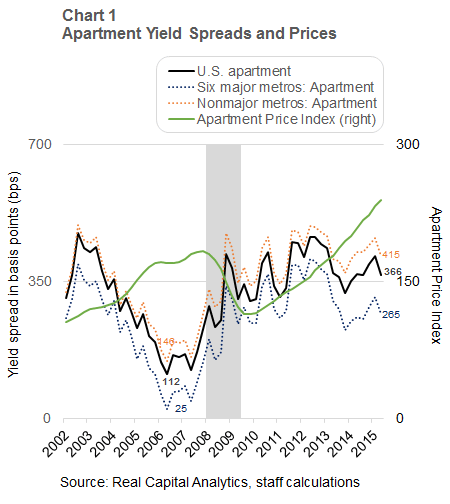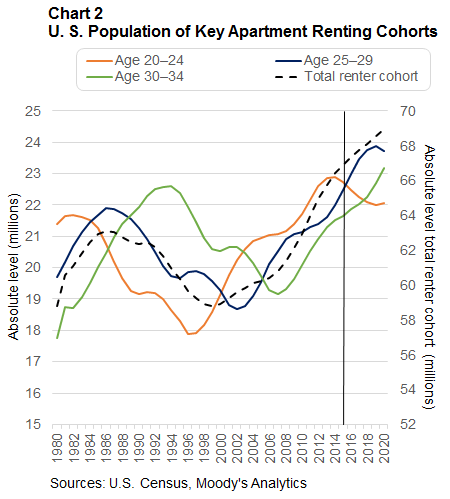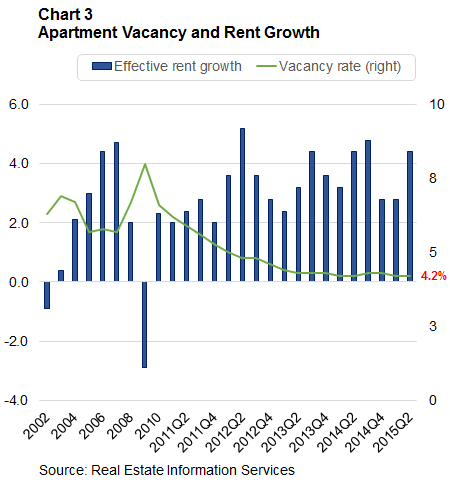Moody's/RCA National commercial property price index, which is based on repeat-sales transactions, has risen 36 percent over the past two years. Such increases in commercial real estate (CRE) prices have raised concerns that the market is overheating (see here). Multifamily is one CRE property type that for a couple of years has been attracting a great deal of lender interest and thus growing concern regarding potential overheating (see here).
Looking around Midtown Atlanta, it is easy to wonder if multifamily housing construction is getting ahead of itself. According to the Midtown Alliance, within just a 0.5-square-mile portion of Midtown Atlanta, 981 units have been recently delivered, 3,392 units are under construction and 4,732 are in various stages of planning. Dodge Pipeline reports that the entire Midtown/Five Points submarket has 4,865 units under way. For reference, peak activity in the Midtown/Five Points area from 2003 to 2007 was 4,636 units under construction with a total of 10,831 units completed. The question arises as to what extent are happenings in Midtown indicative of the broader market trend.
Yield spreads—the capitalization rate on recent apartment transactions (current rental income divided by sales price) minus the yield on Treasury bonds—serve as one indicator of optimism in a market. A narrow spread is consistent with reduced pricing for risk, which is associated with “frothiness.” According to Real Capital Analytics, apartment yield spreads in the second quarter of 2015 stood at 366 basis points (bps), which is around 250 bps higher than prerecession lows and in line with 2003–04 levels (see chart 1). So by this measure, apartment activity does not appear too frothy on a nationwide market basis.

Of course, yield spreads vary significantly by market area and by property type. Breaking the U.S. market into six major markets (Boston; New York; Washington, D.C.; Chicago; San Francisco; and Los Angeles) and all others reveals that the major markets have seen yield spreads fall relative to all other markets. (The major markets account for 36 percent of transaction dollars with New York and San Francisco alone accounting for 20 percent of the U.S. total.) Though shrinking during the last several quarters, the current 150 bps gap between the major and non-major markets is wider than at any time since 2002. One possible explanation is that the anticipated rent growth of the projects sold in the major markets is higher than in nonmajor markets.
So what to make of this? While multifamily markets have been active during the postrecession period, this activity is not necessarily unjustified. Given that the population of 20- to-34-year-olds will continue to grow, demographics point to greater demand for rental property (see chart 2). Supply has not yet shown signs of deteriorating fundamentals since vacancy rates have remained low as new product has been delivered, and rent growth has held steady (see chart 3).


How long will preferences for renting persist? How long can real rents continue to grow? How is this new activity being financed? If new projects are penciled out using unrealistic rent growth assumptions and demand falls, rent growth expectations won't be met and the projects may look overdone in retrospect. Regardless of whether current activity indicates overheating, it seems important to keep a close eye on demand.
 By Carl Hudson, director for the Center for Real Estate Analytics in the Atlanta Fed's research department
By Carl Hudson, director for the Center for Real Estate Analytics in the Atlanta Fed's research department


